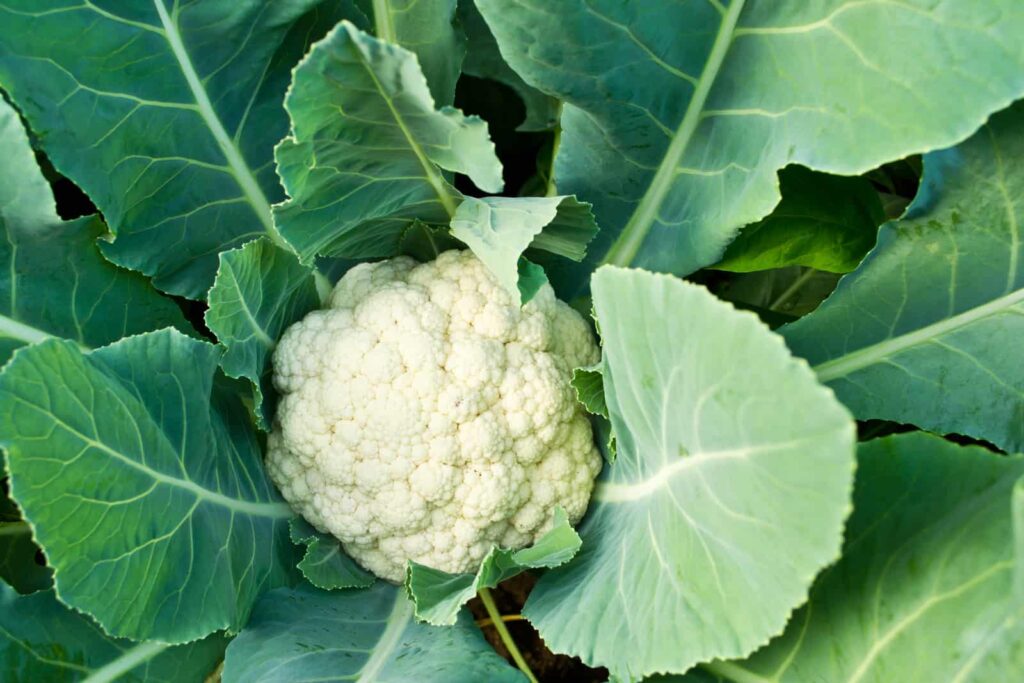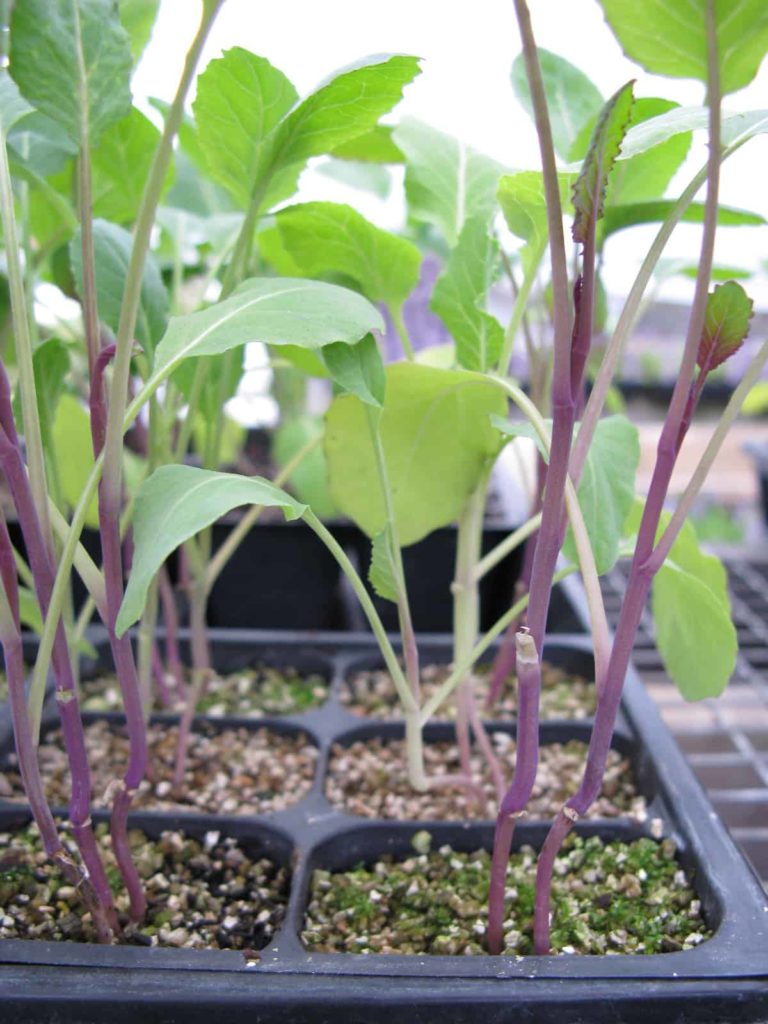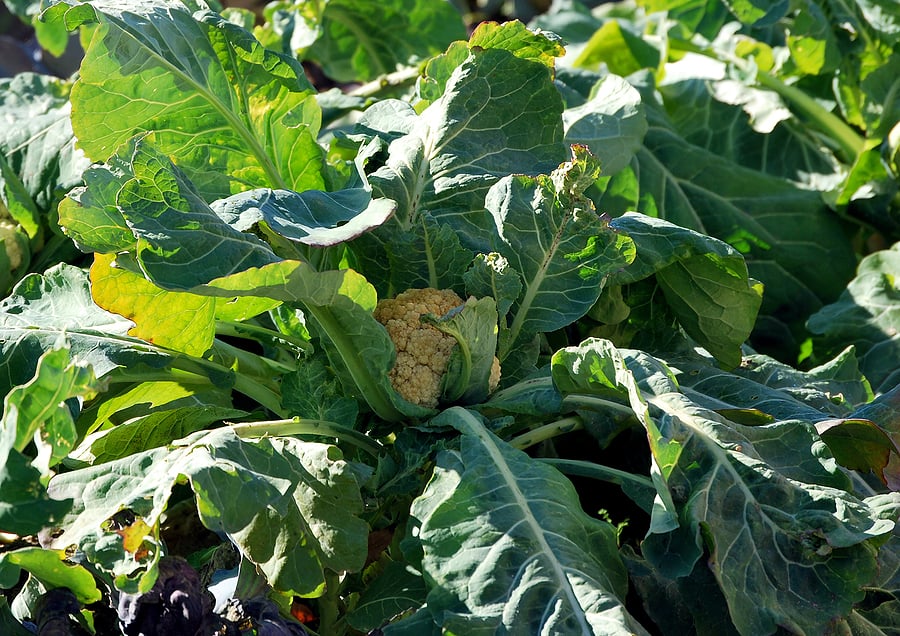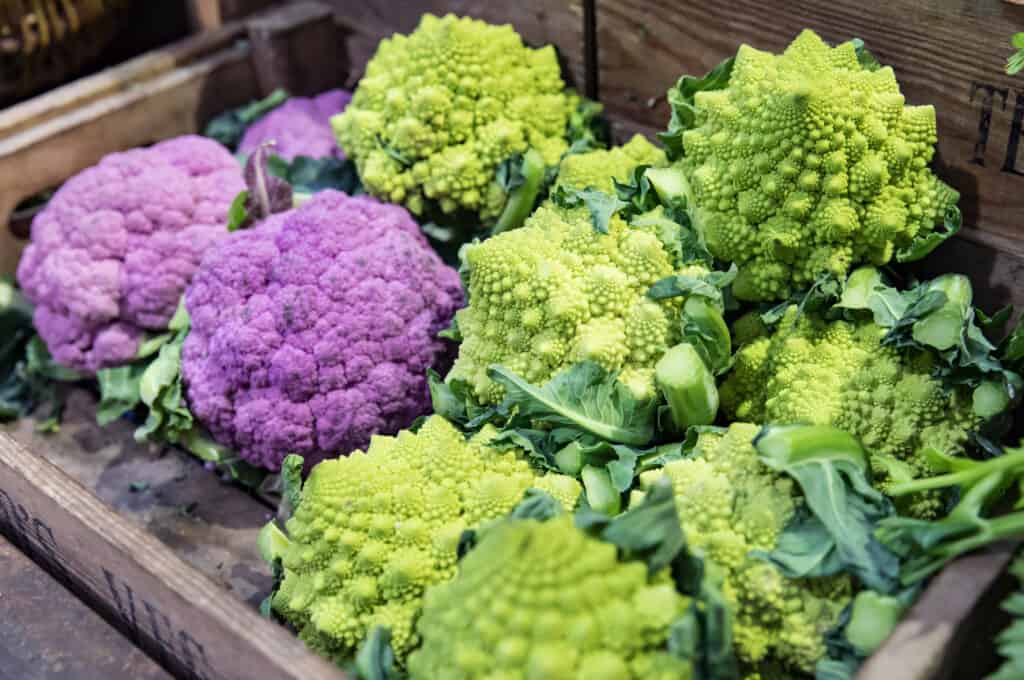Cauliflower is grown for its edible flower buds that form a solid head atop single stalks. The heads are edible raw or cooked.
While cauliflower is perhaps the most delicious member of the cabbage family, it is also the most finicky to grow in the home garden. When the conditions are right, even the novice can grow cauliflower successfully; otherwise, even the most skilled grower may fail.
Cauliflower is a cool-weather half-hardy biennial grown as an annual. It requires 55 to 100 days of cool, even temperatures to reach harvest. The plant resents heat and dryness; it is a voracious but “choosy” feeder requiring deep, rich loamy soil abundantly supplied with quickly available plant food.
Related articles:
- Seven Easy Ways to Serve Cauliflower
- Cauliflower Seed Starting Tips
- How to Harvest and Store Cauliflower
- Cauliflower Growing Problem Troubleshooting

As cauliflower will not stand the heat, it will also not tolerate frost. A frost-free cool location with plentiful moisture is ideal. In warm locations such as the South, cauliflower must be grown only in the cool seasons. In the North, it can be grown as an early and late crop, just like cabbage.
Cauliflower flower heads are sometimes called curds. Heads can be cream, white, purple, or green colored. Broccoflower is a hybrid cross between cauliflower and broccoli. Broccoflower has green heads.
Good Products At Amazon For Growing Cauliflower and Cabbage Family Crops:
- Neem Bliss 100% Cold Pressed Neem Oil
- Monterey BT Caterpillar Killer
- PyGanic Botanical Insecticide
- Captain Jack’s Dead Bug Brew
- Live Ladybugs
- Natures Good Guys Beneficial Nematodes
- Yellow Sticky Traps
- Southern Ag Liquid Copper Fungicide
- MycoStop Biofungicide
Cauliflower growing quick tips
- Start cauliflower seed indoors 6 to 10 weeks before the last frost in spring. Transplants can go into the garden 2 to 6 weeks before the last frost, usually 6 weeks after sowing.
- Direct seed cauliflower into the garden where the soil temperature is between 65°F and 75°F (18-24°C) and the weather will remain cool.
- Crops for a fall harvest can be direct-seeded 8 to 12 weeks before the first expected frost in fall. Transplants come to maturity in 55 to 80 days; from seed, cauliflower requires 70 to 120 days.
- Cauliflower yield: Plant 1 to 2 plants per household member.
Where to plant cauliflower
Cauliflower prefers full sun but will grow in light shade. Plant cauliflower in well-drained soil high in organic matter. Add compost to the soil at planting time. A soil pH within the 6.5 to 7.5 range will discourage disease and allow plants to make the most of soil nutrients.
- Plant cauliflower in full sun. Broccoflower prefers partial shade.
- Cauliflower grows best in rich, well-drained, moisture-retentive soil. Any good soil that is cool and moist can grow cauliflower.
- Cauliflower prefers a soil pH within the 6.5 to 8.0 range.
- Add aged compost to planting beds before planting.

Good Products at Amazon for Seed Starting Success:
- Jump Start Germination Station w/Heat Mat Tray, 72-Cell Pack, Dome
- Espoma Seed Starting Mix
- 200 Count- Jiffy 7 Peat Soil Seed Starting Plugs
- Seed Starter Kit with Humidity Dome (120 Cells Total Tray)
- AgrobriteT5 Fluorescent, 2-Foot, Grow Light System
When to plant cauliflower
Cauliflower requires slow, steady growth in cool weather. Hot weather will cause cauliflower to bolt or button up (cold weather will also cause cauliflower to button—not form full-sized heads). Start cauliflower in early spring 4-6 weeks before the last frost then transplant seedlings after the last frost. In mild-winter regions start cauliflower in autumn to mature in the mild winter.
- Cauliflower requires 55 to 100 days of cool, even temperatures to reach harvest.
- Cauliflower is usually grown from transplants. Start cauliflower seed indoors 6 to 10 weeks before the last frost in spring.
- Seedlings started indoors can go into the garden 2 to 6 weeks before the last frost when plants have 4 to 5 true leaves.
- Cauliflower seeds germinate in about 10 days at 45°F (7°C).
- Direct seed cauliflower into the garden where the soil temperature is between 65°F and 75°F (18-24°C) and the weather will remain cool.
- Cauliflower for a fall crop can be direct-seeded 8 to 12 weeks before the first expected frost in fall. Cauliflower does not like extremes of temperature, hot or cold; it does not tolerate dry conditions.
- In mild frost-free winter regions, plant cauliflower in autumn for a winter harvest. Extreme temperatures will cause cauliflower to bolt and go to seed.
Cauliflower planting calendar
Cauliflower is a cool-season vegetable that requires from 90 to 120 days to mature and reach harvest. During the cauliflower growing season, temperatures should range between 55ºF and 80ºF (13-27ºC). Cauliflower grown in hot or dry conditions can form loose, “ricey” heads. Conversely, cauliflower also does not do well in very cold weather.
- Spring crop. Cauliflower needs two cool months in which to mature. For a spring crop plant set out transplants 4 to 6 weeks before the average date of the last frost in your area. Sow seed 6 weeks before your outdoor planting date.
- Autumn and winter crops. Sow cauliflower seed 90 to 120 days before the first frost in your region, or plant to protect plants that mature after the first frost in autumn. Plastic tunnels will protect cauliflower after the first frost. Plant cauliflower for a winter crop if your winters are mild.
- Succession planting. Plant just a few heads at a time. For succession crops, plant seeds and transplants at the same time for succession crops, or plant early and midseason varieties at the same time.
More tips: Planting Cauliflower.
Planting cauliflower
- Sow cauliflower seeds ½ inch deep and 2 to 3 inches (2.5-7.6cm) apart.
- Cauliflower seeds will germinate in 4-10 days at 65°F (18°C). If you sow seed indoors to start, choose a warm, well-lighted location—in a bright window or under grow lights
- Thin young plants to 15 to 24 inches (38-61cm) apart; space rows 24 to 30 inches (61-76cm) apart.
- Set leggy or cooked-stemmed transplants deeply, up to their first leaves, so that they will not grow top-heavy.
- For succession crops, plant a couple of heads at a time or plant early and midseason varieties at the same time.
Transplanting cauliflower
- Cauliflower seedlings can be transplanted into the garden when they are 4-5 inches (10-13 cm) tall after the last frost.
- Move seedlings to a sheltered place outdoors to “harden off” 1 week before transplanting.
- Thin plants to 15 inches (37.5 cm) apart in a staggered pattern.
- Grow cauliflower in rich, well-drained soil, in full sun.
- Give cauliflower regular water keeping the soil evenly moist.
- Feed cauliflower every 3-4 weeks with fish emulsion or compost tea.
- Blanch curds to improve flavor; fold the outer leaves over the head and tie or pin them at the top with a rubber band
Spacing cauliflower
Cauliflower is usually grown from transplants except where there is a long cool period in which case the seed can be sown directly in the garden. Sow cauliflower seed ½ inch deep and about 3 inches apart. When seedlings are 4 to 6 weeks old with 4 to 5 true leaves transplant seedlings from 18 to 26 inches apart in beds or blocks. Set rows 24 to 36 inches apart. Transplants that are leggy or have crooked stems can be set deeply up to their first leaves so that they do not grow top-heavy.
More tips: Cauliflower Seed Starting Tips.
Good Products at Amazon for Raised Bed Growing
- Galvanized Raised Bed 8×3
- Cedar Raised Bed 4×8
- Elevated Cedar Planter 4×2
- Walk-In Greenhouse Tunnel 15x7x7
- Row Cover for Freeze Protection 10×30
Cauliflower companion plants
- Grow cauliflower with beets, celery, herbs, onions, and potatoes. Avoid pole beans, strawberries, and tomatoes.
Container growing cauliflower
Cauliflower can be grown in a container. A single plant will do well in an eight-inch pot. In a large container, allow 18 inches around for each plant.
- Grow cauliflower in a container at least 8 inches (20cm) deep.
- In large containers, plant cauliflower on 18-inch (45cm) centers.
Watering cauliflower
Cauliflower grows best in moist, not wet soil. Do not allow the soil to dry out. Mulch to keep soil cool and moist. If growth is interrupted by heat, cold, or lack of water the heads will not form properly.
- Cauliflower requires evenly moist soil for uninterrupted, vigorous growth and head formation. Do not let the ground dry out.
Feeding cauliflower
Work plenty of compost into the soil at planting time. Side-dress cauliflower with compost at midseason or more often.
- Cauliflower is a heavy feeder. Add aged compost to the planting bed before planting or place aged compost at the bottom of the planting hole and cover it with a bit of soil. The roots will get a boost when they reach the compost.
- Side-dress cauliflower again at midseason with aged compost or foliar feed with seaweed extra or fish emulsion every three weeks if possible.

Cauliflower care
- Keep cauliflower planting beds free of weeds. Avoid deep cultivation which can damage roots. Keep the area around young plants weed-free especially.
- If the weather gets too dry or hot, the button-like center of the plant will “break,” send up a flower stalk and ruin the plant.
- To force the plants to produce a solid white head (the curd) tie the outer leaves over the center of the plant as soon as the first button-like swelling appears. Don’t tie the leaves so tight that you injure the leaves which must still keep on growing. Leaves bent over the developing head will shield it from the heat of the sun, and gradually (due to the lack of light) turn it white.
- Cauliflower heads will stand no frost.
Blanching cauliflower
- White cauliflower is often blanched to keep the heads white and to protect the heads from rain and too much sun; blanching does not improve flavor greatly.
- Blanch white cauliflower varieties when the head gets to be about the size of an egg: draw three or four outer leaves over the head and secure them with a rubber band or clothespin.
- Check the heads weekly to make sure pests are not hiding under the leaves.
- Self-blanching cauliflower does not need to be tied but it will not blanch in hot weather.
Cauliflower pests
- Cauliflower can be attacked by cutworms, cabbage loopers (preceded by small yellow and white moths), and imported cabbage worms (caterpillars). These pests can be controlled by fine mesh row covers, handpicking, and spraying with Bacillus thuringiensis.
Cauliflower diseases
- Like other members of the cabbage family, cauliflower is susceptible to black rot, clubroot, damping off, downy mildew, leaf spot, yellows, and fusarium wilt.
- Cauliflower is susceptible to root rots–an initial symptom is the yellowing leaves.
- Plant disease-resistant varieties, keep the garden free of debris, and avoid handling plants when they are wet.
- Remove and destroy infected plants immediately so they cannot spread the disease to healthy plants.
- Downy mildew which occurs in cool, wet conditions can cause cauliflower heads to brown.
- Ensure proper drainage; avoid constantly wet conditions; don’t work with plants when they are wet.
- Rotate cabbage family platings to avoid soil-borne diseases.
More on cauliflower pests and diseases: Cauliflower Growing Problems: Troubleshooting.
Harvesting cauliflower
Cauliflower matures 70-120 days after sowing; 55-80 days after transplanting. Cut cauliflower when the heads are firm and tight and reach 4-8” (10-20 cm) in diameter and curds are still tight. Cut the stalk just below the head. In warm weather, harvest about 4 days after tying the leaves for blanching.
- Cauliflower grown from transplants will come to harvest in 55 to 100 days.
- Cauliflower grown from seed will come to harvest in 85 to 130 days.
- Under good growing conditions, cauliflower heads develop rapidly to about 6 to 8 inches in diameter. The mature head should be compact, firm, and white.
- Cauliflower heads will stand no frost, and when they are ready to be picked–when plump, firm, and white–they cannot be left on the plant as a =cabbage head can be. Harvest at once by cutting well below the head.
- If freezing weather is likely, all remaining heads should be harvested.
- Cauliflower heads are easily damaged and must be handled with care.
- Cut the whole head from the main stem. The leaves can be harvested and cooked like collards or cabbage.
More tips: How to Harvest and Store Cauliflower.
Storing cauliflower
- Cauliflower will keep for one week in the refrigerator unwashed and wrapped in plastic.
- Cauliflower can be frozen, and pickled.
Cauliflower in the kitchen
- Serve cauliflower raw or cooked.
- Serve cauliflower as a vegetable side dish or add it to soups, stews, pasta, omelets, souffle, or quiches.

Cauliflower frequently asked questions
Q: Can cauliflower be grown where summers are hot?
A: Start cauliflower indoors 8 to 10 weeks before the last spring frost or in late summer 80 to 100 days before the first killing fall frost. In spring, cauliflower seedlings can go into the garden two weeks before the last expected frost. Cauliflower will do best when it matures in cool weather.
Q: How much water does cauliflower need?
A: Cauliflower must have a regular supply of water so that it grows quickly. Never let the soil dry out, but don’t overwater. Cauliflower grows best when the weather is cool. Keep cauliflower plants cool during hot weather by sprinkling the plants with water; this will keep the air around cauliflower humid.
Q: How can I make sure cauliflower is sweet flavored?
A: Blanch the stalks by bending the outer leaves together over the curds; do this when the curds (center head) are about 3 inches in diameter. Leave them in place until the head matures. Arrange the leaves so that the head stays dry.
Q: When is the right time to harvest cauliflower?
A: Cut the heads from the stalks when the curds are still tight, about two weeks after tying the leaves over the curds. If the weather is warm, check the curds every day or two to make sure they don’t swell and form flowers.
Q: What is self-blanching cauliflower?
A: Self-blanching cauliflower varieties naturally grow leaves over the curds; you don’t need to tie the leaves.
Cauliflower varieties to grow
Check the cultivar to be sure it is suited to the growing season: spring, summer, and autumn, or winter.
- White: ‘Candid Charm’ (75 days); ‘Cashmere’ (52 days); ‘Dominant’ (68 days); ‘Inca White’ (70 days); ‘Incline’ (76 days); ‘Majestic’ (66 days); ‘Ravella’ (70 days); ‘Rushmore’ (51 days); ‘Self-Blanche’ (70 days); ‘Serrano’ (63 days); ‘Sierra Nevada’ (68 days); ‘Siria’ (65 days); ‘Snowball’ (59 days);’ Snow Crown’ (50-68 days); ‘Snow King’ (60 days);’ Pak’ (62-85 days); ‘Solide’ (67 days); ‘Starbrite’ (68 days); ‘Super Snowball’ (55 days); ‘White Rock’ (69-100 days); ‘White Sails’ (68 days); ‘Yukon’ (71 days).
- Purple: ‘Burgundy Queen’ (70 days); ‘Sicilian Purple’ (85 days); ‘Purple Cape’ (200 days); ‘Violet Queen’ (55-65 days).
- Green and Broccoflower: ‘Chartreuse’ (62 days).
About cauliflower
- Common name. Cauliflower
- Botanical name. Brassica oleracea botrytis
- Origin. Europe, Mediterranean
Cauliflower articles at Harvest to Table:
How to Plant and Grow Cauliflower
Cauliflower Seed Starting Tips
How to Harvest and Store Cauliflower
Cauliflower Growing Problem: Troubleshooting
Seven Easy Ways to Serve Cauliflower
More how to grow tips:
Learn how to plant, grow, and harvest your favorite vegetables. Click below for all you need to know.
- Artichoke
- Arugula
- Asparagus
- Beans, Snap
- Beets
- Broad Beans
- Broccoli
- Brussels Sprouts
- Cabbage
- Cantaloupe — Melons
- Cardoon
- Carrots
- Cauliflower
- Celeriac
- Celery
- Chard
- Chayote Squash
- Chickpeas
- Chicory
- Chinese Cabbage
- Collards
- Corn Salad
- Corn, Sweet
- Cresses
- Cucumbers
- Eggplant
- Endive and Escarole
- Fava Beans
- Florence Fennel
- Garbanzo Beans
- Garlic
- Horseradish
- Jerusalem Artichoke
- Kale
- Kohlrabi
- Leeks
- Lettuce
- Lima Beans
- Melons
- Mizuna
- Mustard Greens
- New Zealand Spinach
- Okra
- Onions
- Parsnips
- Peanuts
- Peas
- Peppers
- Potatoes
- Pumpkins
- Radicchio
- Radishes
- Rhubarb
- Rutabaga
- Salsify
- Shallots
- Sorrel
- Southern Peas
- Soybeans
- Spinach
- Squash, Summer
- Squash, Winter
- Sunchokes
- Sweet Potato
- Swiss Chard
- Taro
- Tomatillo
- Tomatoes
- Turnips
- Watermelon
- Zucchini
Grow 80 vegetables and herbs: KITCHEN GARDEN GROWERS’ GUIDE















